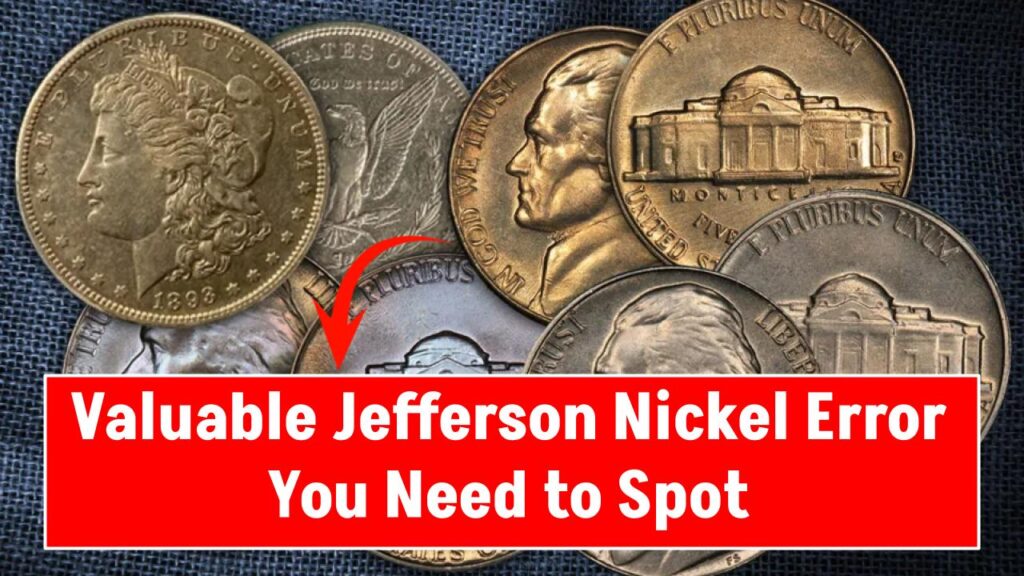Jefferson Nickel: If you’re holding onto some old change, you might want to take a closer look—especially at your Jefferson nickels. Thanks to rare minting errors, some of these coins have fetched thousands of dollars in auctions and private sales. What may look like an ordinary nickel in your pocket could be a small fortune waiting to be discovered.

In this article, we’ll walk you through the most valuable Jefferson nickel errors, how to identify them, and how to get your coins appraised or graded. Whether you’re a seasoned collector or just someone cleaning out a coin jar, this guide could lead you to your next big find.
This Mistake on a Jefferson Nickel Made It Worth Thousands
| Feature | Details |
|---|---|
| Topic | Rare Jefferson nickel errors that are worth thousands of dollars |
| Top Error Example | 1939 Doubled Die Reverse (DDR) – Up to $23,500 |
| Other High-Value Errors | 1974 Double-Struck ($17,500), 1943 Overdate ($16,675), 1971-S No Mint Mark Proof ($8,100) |
| Common Error Types | Doubled die, overdate, off-center strike, missing mint mark, improper planchet |
| Grading Authority | PCGS and NGC are trusted coin grading services |
| Next Steps | Identify, verify with a magnifier, and get your coin professionally graded |
| Official Resources | PCGS, NGC, Coin Value Checker |
Why Jefferson Nickels?
The Jefferson nickel, first minted in 1938, is one of the most iconic and widely circulated U.S. coins. Over the decades, millions have been produced—but occasionally, something goes wrong at the mint. These mistakes, when caught and preserved, can turn an ordinary 5-cent piece into a collector’s treasure.
Unlike most modern coins, Jefferson nickels have produced some notoriously rare errors, making them a hot topic in numismatic circles.
Most Valuable Jefferson Nickel Errors (With Prices)
1. 1939 Doubled Die Reverse (DDR)
- What to look for: Clear doubling on the inscriptions “MONTICELLO” and “FIVE CENTS”.
- Why it’s valuable: Doubling is crisp and easily visible even with minimal magnification. Full Steps coins command even higher prices.
- Recent sale value: Up to $23,500 (Source).
2. 1974 Double-Struck on Another Nickel
- What to look for: Overlapping design elements, with two impressions on the same coin.
- Why it’s valuable: These dramatic errors are rare and visually striking.
- Recent sale value: $17,500.
3. 1943-P 3 Over 2 Overdate
- What to look for: A “3” printed over a faint “2” in the date.
- Why it’s valuable: This overdate error occurred during WWII when the composition of nickels changed.
- Recent sale value: $16,675.
4. 1971-S No Mint Mark Proof (DCAM)
- What to look for: A proof coin with no “S” mint mark.
- Why it’s valuable: Proofs are always struck at San Francisco (with an “S” mark). Missing it makes the coin a standout error.
- Recent sale value: Up to $8,100 in DCAM condition.
5. 2020 Double-Struck and Off-Center
- What to look for: A noticeably off-center strike and a second, overlapping strike.
- Why it’s valuable: Recent errors are harder to find in circulation, making modern examples especially appealing.
- Recent sale value: $2,999.
6. 2006-P Improperly Annealed Planchet
- What to look for: Unusual coppery coloration or blotchy texture.
- Why it’s valuable: It reflects a rare planchet preparation error before the strike.
- Recent sale value: $710.
Jefferson Nickel: How to Identify Valuable Jefferson Nickel Errors?
Use a Magnifying Glass
Even a 10x loupe is enough to help you catch doubling or overdates.
Look for “Full Steps”
On the reverse side, if all six steps of Monticello are visible without any breaks, it greatly enhances the coin’s value—especially in high grades.
Check the Mint Mark Area
On older nickels, the mint mark is located on the reverse; on newer ones, it’s on the obverse. A missing or misplaced mint mark can be a huge clue.
Assess Strike Quality
Coins that are double-struck or off-center are easier to spot, and even slight misalignments can be valuable if the error is significant enough.
Getting Your Coin Appraised
Step 1: Compare Online
Use trusted sites like NGC’s Price Guide or PCGS to see if your coin matches any known error types.
Step 2: Use a Coin Grading Service
Professional Coin Grading Services like PCGS or NGC offer authentication and valuation. A graded coin also sells for more in the market.
Step 3: Join a community
Reddit’s r/coins or the PCGS coin forums are full of enthusiasts and professionals who can offer guidance or second opinions.
Selling Your Valuable Nickel
If you confirm you have a rare Jefferson nickel, consider these options to sell:
- Auction Houses: Heritage Auctions and Stack’s Bowers specialize in high-value coins.
- Online Marketplaces: eBay and Etsy, but only after grading.
- Coin Shows: These are ideal for meeting professional buyers face-to-face.
- Dealers: Certified dealers (often listed on PCGS or NGC) may make you an instant offer.
Rare Jefferson Nickel Alert: The Secret Minting Error That Could Make You a Fortune
From Rust to Riches: $40,000 Nickel Found in Forgotten Tackle Box
This Penny Sold for $11 Million—Check Your Change Before You Spend a Fortune by Mistake
FAQs About Jefferson Nickel
Q1. What makes a Jefferson nickel valuable?
Errors like doubled dies, overdates, missing mint marks, or double strikes. Rarity, condition, and “Full Steps” status also play a role.
Q2. Can I find these in regular circulation?
Yes, though rare, some collectors have found high-value nickels in pocket change or inherited coin jars.
Q3. What’s the safest way to verify my coin?
Use a coin grading service like PCGS or NGC. Avoid self-diagnosing unless you’re very experienced.
Q4. Does cleaning the coin reduce its value?
Yes—never clean coins, as even light polishing can damage them and drastically reduce value.
Q5. Is every old nickel valuable?
No. Only those with unique mint errors, low mintages, or pristine conditions have significant value.










